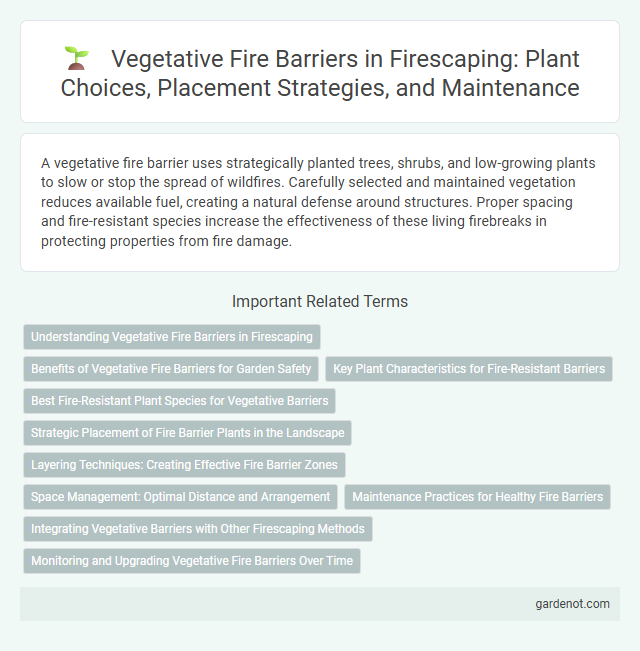A vegetative fire barrier uses strategically planted trees, shrubs, and low-growing plants to slow or stop the spread of wildfires. Carefully selected and maintained vegetation reduces available fuel, creating a natural defense around structures. Proper spacing and fire-resistant species increase the effectiveness of these living firebreaks in protecting properties from fire damage.
Understanding Vegetative Fire Barriers in Firescaping
Vegetative fire barriers in firescaping consist of strategically placed plants and landscaping features designed to slow or stop the spread of wildfire by reducing fuel continuity. These barriers typically include fire-resistant species with high moisture content and low resin levels, such as succulents, deciduous trees, and carefully maintained grasses. Proper planning and regular maintenance are essential to ensure the effectiveness of vegetative fire barriers in creating defensible space around properties.
Benefits of Vegetative Fire Barriers for Garden Safety
Vegetative fire barriers significantly reduce the risk of wildfire damage by creating strategically placed, fire-resistant plant zones that slow fire spread and protect garden assets. These barriers enhance garden safety by using plants with high moisture content and low flammability, which act as natural firebreaks while maintaining aesthetic appeal. Integrating drought-tolerant, low-resin species further minimizes fuel load and supports sustainable, fire-resilient landscape design.
Key Plant Characteristics for Fire-Resistant Barriers
Key plant characteristics for fire-resistant vegetative barriers include high moisture content, low resin or oil levels, and minimal dead material accumulation, which reduces flammability. Plants with thick, succulent leaves and deep root systems enhance fire resistance by maintaining hydration and soil stability. Selecting native, drought-tolerant species that resist ignition and promote safety in firescaping is essential for an effective vegetative fire barrier.
Best Fire-Resistant Plant Species for Vegetative Barriers
Best fire-resistant plant species for vegetative fire barriers include California lilac (Ceanothus), manzanita (Arctostaphylos), and rosemary (Rosmarinus officinalis) due to their low resin content and high moisture retention. These plants create effective firebreaks by reducing fuel availability and slowing fire spread. Incorporating native, drought-tolerant species enhances the durability and ecological compatibility of the vegetative fire barrier.
Strategic Placement of Fire Barrier Plants in the Landscape
Strategic placement of fire barrier plants involves situating drought-resistant, low-flammability species such as succulents and deciduous trees to interrupt wildfire fuel continuity. Fire-resistant vegetation should be positioned near structures and along property perimeters to create defensible spaces that reduce radiant heat and slow fire spread. Incorporating appropriate plant spacing and layering enhances the effectiveness of vegetative fire barriers in minimizing wildfire risk.
Layering Techniques: Creating Effective Fire Barrier Zones
Layering techniques in vegetative fire barriers involve strategically arranging plant species with varying flammability, moisture content, and density to reduce fire spread effectively. Incorporating low-flammable, moisture-rich plants near structures and progressively increasing fire-resistant vegetation in outer zones creates multiple defensible spaces. This method minimizes heat transfer and slows fire progression, enhancing overall landscape resilience during wildfire events.
Space Management: Optimal Distance and Arrangement
Vegetative fire barriers require strategic space management to maximize fire resistance, typically maintaining a minimum clearance of 30 feet between combustible plants and structures. Arranging plants with varying moisture content and fire-retardant properties in staggered patterns reduces continuous fuel loads and slows fire spread. Optimizing plant spacing and selection according to local fire codes enhances the overall effectiveness of the fire barrier in defensible space zones.
Maintenance Practices for Healthy Fire Barriers
Regular inspection and pruning of plants within vegetative fire barriers are essential for preventing the accumulation of dry, combustible material. Maintaining appropriate moisture levels through targeted irrigation supports plant health and reduces fire risk. Removing invasive species and debris helps sustain barrier density and effectiveness as a firebreak.
Integrating Vegetative Barriers with Other Firescaping Methods
Integrating vegetative fire barriers with hardscaping elements such as stone paths and gravel beds enhances overall fire resistance by creating effective breaks in fuel continuity. Incorporating fire-resistant plants alongside strategically placed irrigation systems further reduces combustible material and maintains moisture levels. Combining these methods with routine maintenance practices optimizes landscape resilience against wildfires.
Monitoring and Upgrading Vegetative Fire Barriers Over Time
Regular monitoring of vegetative fire barriers involves inspecting plant health, density, and moisture levels to ensure effective fire resistance. Upgrading these barriers requires integrating fire-resistant species, removing dead or flammable vegetation, and maintaining optimal spacing to reduce fuel continuity. Consistent management enhances the barrier's ability to slow or stop wildfire spread in vulnerable areas.
Vegetative fire barrier Infographic

 gardenot.com
gardenot.com